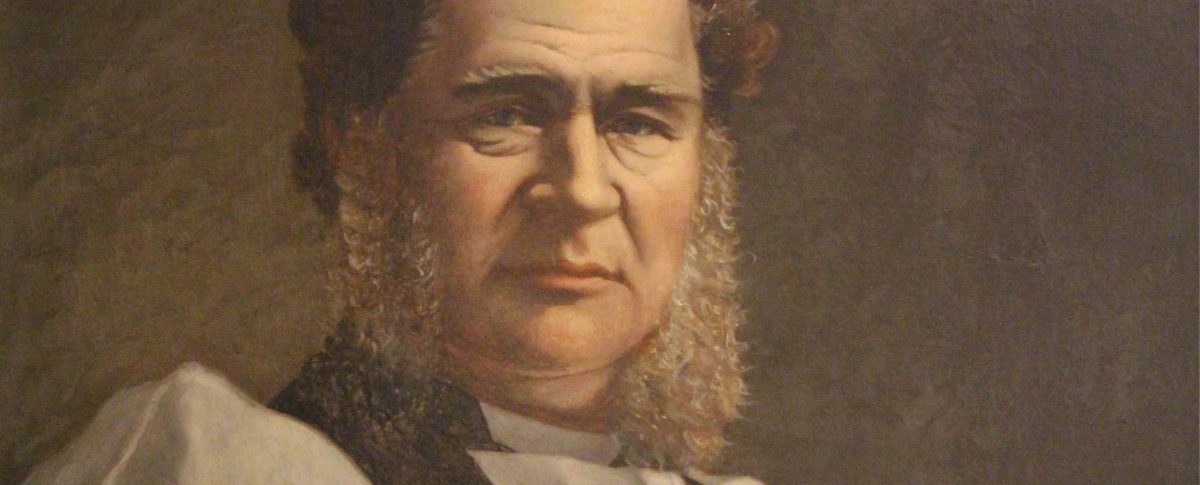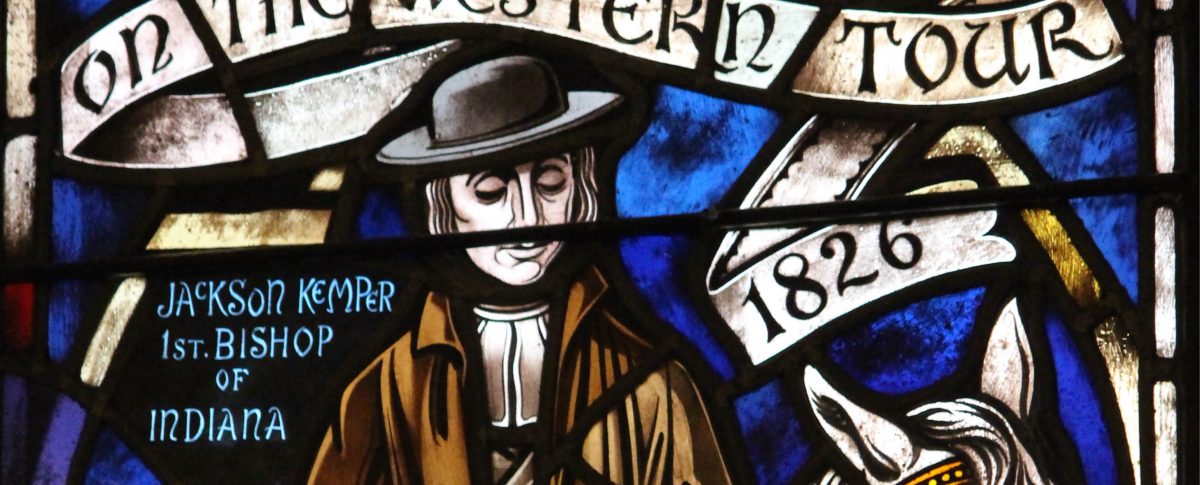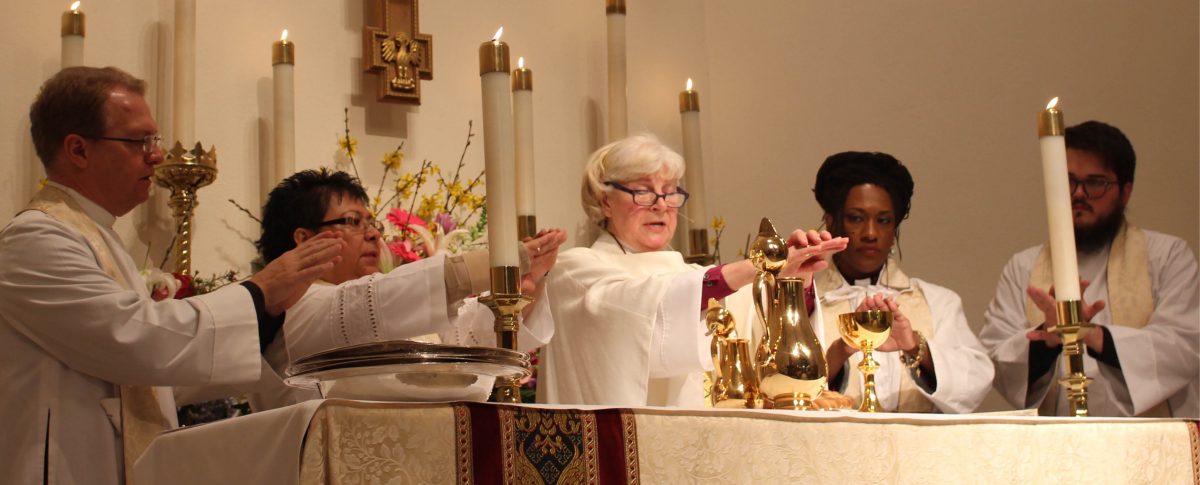As the Episcopal Diocese of Indianapolis will soon elect the 11th Bishop, we take a look back in time to the history of the Episcopal Bishops of our state.
Jackson Kemper, the first missionary bishop of the Episcopal Church in the United States of America, was born on Christmas Eve in 1789 in Pleasant Valley, New York. He was ordained a priest in 1814 and spent twenty years as Bishop William White’s assistant in Philadelphia. In 1835 Kemper was unanimously elected Bishop of Indiana and Missouri. Bishop Kemper first saw Indiana in November and recorded in his diary, “Indiana looked woody, interesting, and inviting.”
It was Bishop Kemper, on a bright December 16th, 1837, who consecrated the foundation of Christ Church. Kemper constantly urged outreach to the Native American peoples, and translations of the Scriptures and the services of the Church into their languages.
In 1842 at the fourth annual convention of the Indiana Episcopal parishes, Bishop Kemper was unanimously re-elected Bishop, but reluctantly refused due to his duties in the wider field of the church. Regrettably, finding a Bishop was more difficult than expected and it was not until 1849 that Rev. George Upfold of the Diocese of Pennsylvania accepted the honor and responsibility.
On the third Sunday in Advent, December 16th, 1849, Rev. Upfold was consecrated the second Bishop of Indiana, the fiftieth Bishop in the Episcopal Church of the USA, at Christ Church. He wrote of the day, “Just as I had been consecrated and had taken my seat as bishop in the chancel, the sun, which had been obscured by clouds for several days, suddenly shone forth in its brightness, and then again passed under a cloud. God grant this may be exemplified in the prosecution of my labors in this vast field of labor.”
During his first few years in Indiana, Bishop Upfold served as priest for St. John’s Church in Lafayette, Indiana and Christ Church in Indianapolis. It was only in 1855 that the diocese became financially stable enough for Upfold to concentrate on his duties as Bishop and realizing that the center of activity of the diocese was in Indianapolis, he moved to the city in 1857. The Rev. Dr. Joseph Talbot was elected as a coadjutor bishop in 1865. A coadjustor bishop is a bishop who is designated to assist the diocesan bishop in the administration of the diocese, until the Bishop’s death. Bishop Upfold died in 1872 and is buried at Crown Hill Cemetery, Indianapolis.
The Rev. Dr. Joseph Talbot served as Rector of Christ Church for seven years and is credited for building the current church building. He served until 1860, when he was elected the Missionary Bishop of the Northwest. The Missionary District of the Northwest included New Mexico, Dakota, Wyoming, Colorado, Arizona, Utah, Montana, and Idaho, covering nearly nine hundred thousand square miles. Talbot referred to himself as “Bishop of All Outdoors.”
On Aug. 23, 1865, Talbot was elected Assistant Bishop of Indianapolis and returned to Indiana. Talbot was consecrated Bishop at Christ Church on February 15th, 1872 and served faithfully until his death in 1883. His obituary in the New York Times closed, “He was of prepossessing manner, a strong preacher, and died full of honors.”
Succeeding Bishop Talbot was the Rev. David Knickerbacker, a rector from Minneapolis, who was consecrated on October 14th, 1883 in St. Mark’s Church in Philadelphia. It was Bishop Knickerbacker who moved Grace Church (Grace Cathedral) to Sixteenth Street off of Central Avenue (the current All Saints Episcopal Church) where he had bought a quarter of the block for a cathedral. He built a school for girls and a home for aged ladies, but there were not enough of the latter to make the building a success and so it was turned over to other uses. “There was a spirit of tranquility and generosity surrounding all he said and did,” remembered the Episcopal Bishops in Indiana. The Vestry minutes of Christ Church called him, “Wise in counsel, fertile in resources, courageous in action, inspired by an unquenchable faith.”
It was Bishop Knickerbacker who worked with the General Convention in Washington DC to split the Diocese in two to better serve the growing congregation. The 1898 Episcopal General Convention agreed and split the Diocese into two, the Central and Southern Indiana from Northern Indiana.
The Rev. John Hazen White was elected to the role of Bishop in 1895, consecrated at St. Paul’s Church in May. Bishop White served until the decision to split the state into the Episcopal Diocese of Indianapolis from the Episcopal Diocese of Northern Indiana in 1898. Bishop White then led the new diocese of Northern Indiana from 1899-1925.
To fill the vacancy the Rev. Joseph Marshall Francis of Evansville was elected to Bishop in an election that was debated into the night past 1am. Finally, “26 weary clergy, and 23 of the yawning lay members” successfully ended the election. He was consecrated in his own church in Evansville on September 21st and moved to Indianapolis the next week. It was under Bishop Francis the Diocese was renamed from Indiana to Indianapolis, making him the first Bishop of the Diocese of Indianapolis.
Bishop Francis had been a missionary in Japan for ten years and served as chaplain and censor of the Indianapolis Base Hospital No. 32 at Contrexeville, France in World War I. He received the Crown of Belgium Medal, given for outstanding civil activities. He was noted, “for personal generosity far beyond the call of duty.”
Bishop Francis fell ill in 1939 and applied for a bishop coadjutor so that he could have the satisfaction of seeing a worthy sucessor prepare to become Bishop. There were some appeals to recombine the Dioceses of Indianapolis and Northern Indiana, as neither of the Dioceses had yet become strong, but Bishop Francis appealed to remain separate and the clergy objected to the high churchmanship of Northern Indiana.
The Rev. Richard Kirchhoffer, rector of Christ Church in Mobile, Alabama, was elected the Bishop Coadjutor. He was consecrated at St. Paul’s Church just five days before the death of Bishop Francis. Under Bishop Kirchhoffer’s leadership at the annual diocesan convention in Terre Haute on May 3rd, 1953 it was suggested that Christ Church on the Circle become the Cathedral of the Diocese after a sizeable gift from Mr. Eli Lilly.
The Rev. John Craine came to Christ Church from Trinity Church, Seattle in 1949, becoming the Dean of the Cathedral. In 1957 Rev. Craine was elected the bishop coadjutor of the diocese to assist Bishop Kirchhoffer, and in 1959 became Diocesan Bishop. The Encyclopedia of Indianapolis noted, “John Craine made perhaps more of an impact on the local church than any of his predecessors as bishop. It was the era of agitation for civil rights and of civil disobedience, of Vietnam and community action. Bishop Craine… with the financial support of Eli Lilly, believed that the church should be in the forefront of action.”
It was also under Bishop Craine that significant challenges to the church were met. The first women clergy were ordained and in the Diocese of Indianapolis the Reverends Jacqueline Means and Tanya Vonnegut Beck were welcomed into the clergy. The Episcopal Diocese of Indianapolis endorsed changes in the national church, including revisions to the Prayer Book in 1978, providing alternative services, the passing of the peace, and the use of the laity to administer the chalice.Bishop Craine died the same year as Eli Lilly, in 1977.
The Rev. Edward Jones was elected bishop coadjutor of Indianapolis in March of 1977, and consecrated on September 10 that same year as diocesan Bishop. Bishop Jones saw the church continue to live into the revised Book of Common Prayer and Hymnal. He held the position of Bishop for 20 years until his retirement in 1997. Upon his death Bishop Waynick noted, “Bishop Ted served this diocese faithfully and with great care and gentleness for two decades. His ability to see and affirm the very best in every person gave him a generosity of spirit which is rare and precious.”
The Rev. Catherine Waynick was elected Bishop Coadjuctor in January of 1997 and the Diocesan Bishop on September 10th, 1997, making her the fifth woman Bishop in the world. Bishop Waynick served the Diocese under many difficult events, including the September 11th terrorist attacks. Bishop Waynick is known for her contributions to the Diocese in Stewardship and for building the companion relationships between the Diocese of Brasilia in Brazil, and the Diocese of Bor in Southern Sudan.
Bishop Waynick continues the legacy of compassion and action among our churches, calling for the church to respond to the world. As she said in her Easter Vigil sermon, “Jesus, God in the flesh, is no temporary interloper. In Jesus, God has taken up residence within human life, and what Jesus does among us is unbound by time and place. At every moment Jesus the Christ is born among us. At every moment Jesus the Christ is rejoicing with those who celebrate human creativity, human compassion, humor, and love.”
When the next bishop is consecrated, the episcopate of the 11th Bishop will begin. Bishop Waynick will not elect a bishop coadjutor to serve alongside her, but pass the croizer directly to a new bishop. It is the hope that the new bishop-elect will come to Indianapolis in January of 2017 to work closely with Bishop Waynick before her retirement in April.
The election of the next Bishop will occur at Christ Church Cathedral on Friday, October 28th, 2016 by 100 clergy and 200 delegates from parishes. We continue to pray for discernment during the search for the next Bishop of Indianapolis, for the Search and Transitions Committees, for all who are nominated, and for all those who shall elect our new bishop.

